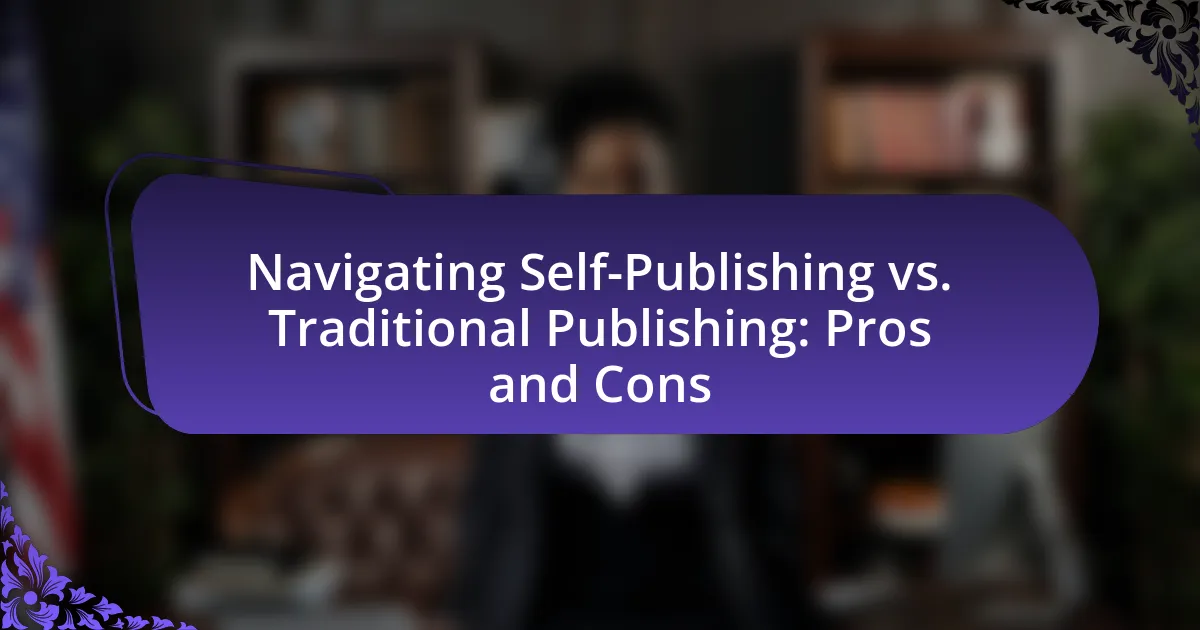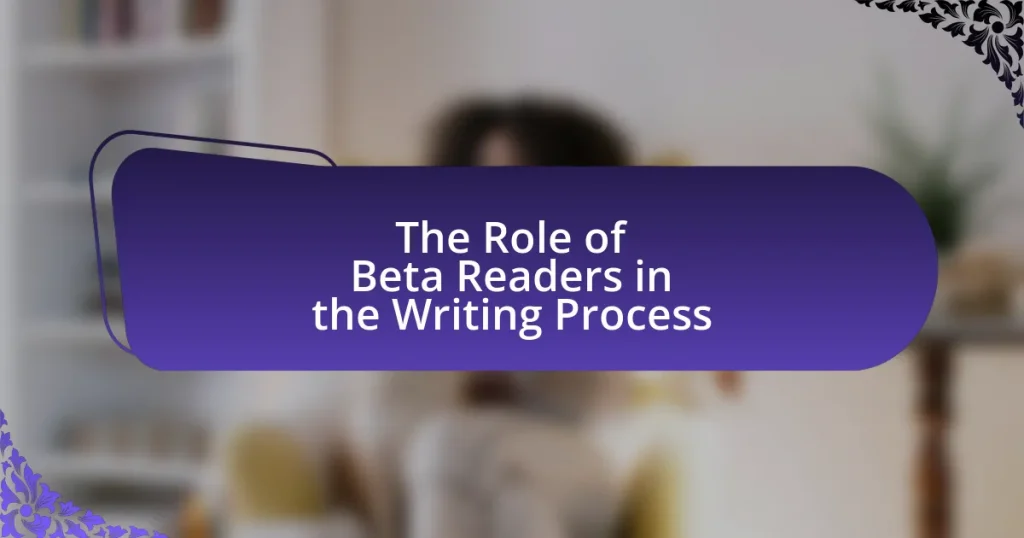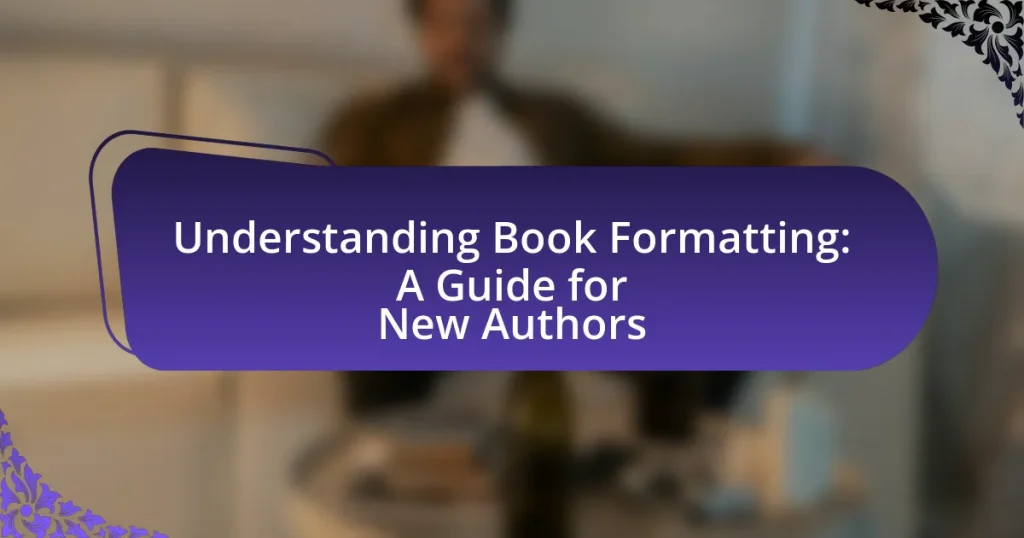The article examines the key differences between self-publishing and traditional publishing, highlighting the advantages and disadvantages of each route. Self-publishing offers authors greater creative control and higher royalty rates, often allowing them to retain up to 70% of sales, while traditional publishing typically provides support in editing, marketing, and distribution but results in lower royalties of 10-15%. The article outlines the self-publishing process, including steps such as manuscript preparation, platform selection, and marketing strategies, as well as the challenges authors face, such as quality control and visibility. Additionally, it discusses the financial implications, emotional challenges, and key considerations for authors when choosing between these two publishing paths.
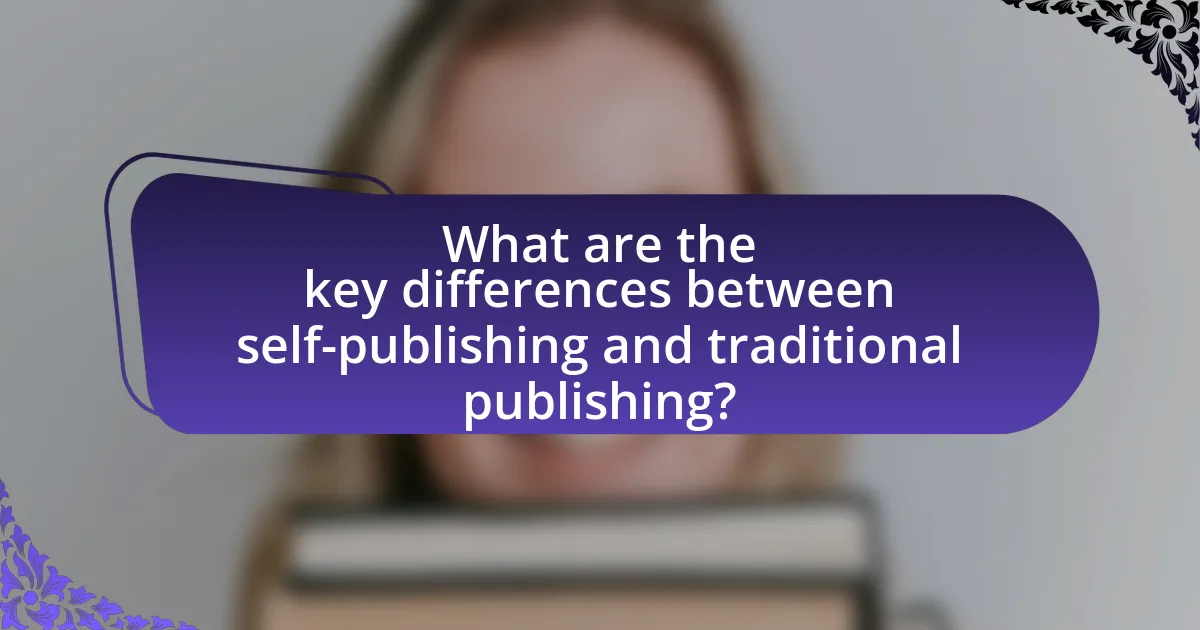
What are the key differences between self-publishing and traditional publishing?
Self-publishing allows authors to retain full creative control and a higher percentage of royalties, while traditional publishing typically involves a publisher managing the production, distribution, and marketing of the book, often resulting in lower royalties for the author. In self-publishing, authors are responsible for all aspects of the publishing process, including editing, design, and marketing, whereas traditional publishing provides these services but requires authors to submit their work for approval and often involves a lengthy selection process. According to a 2021 report by the Author Earnings Project, self-published authors can earn up to 70% of their book sales, compared to traditional authors who may earn between 10% to 15% of sales after the publisher takes its cut.
How does the process of self-publishing work?
The process of self-publishing involves several key steps that authors must follow to publish their work independently. First, authors write and edit their manuscript, ensuring it meets quality standards. Next, they choose a self-publishing platform, such as Amazon Kindle Direct Publishing or IngramSpark, which provides tools for formatting and distribution. After selecting a platform, authors format their manuscript according to the platform’s guidelines and create a cover design, either by themselves or through professional services.
Once the manuscript is formatted and the cover is ready, authors upload their files to the chosen platform, set pricing, and select distribution channels. After publication, authors are responsible for marketing their book, which may include social media promotion, book signings, and leveraging online advertising. Self-publishing allows authors to retain creative control and a larger share of royalties, with many self-published authors earning up to 70% of their book’s sales compared to traditional publishing, where authors typically earn around 10-15%.
What steps are involved in self-publishing a book?
The steps involved in self-publishing a book include writing the manuscript, editing the content, designing the cover, formatting the book for print and digital versions, choosing a self-publishing platform, uploading the book, setting a price, and marketing the book. Each step is crucial for ensuring the book is polished and reaches its intended audience effectively. For instance, using platforms like Amazon Kindle Direct Publishing or IngramSpark allows authors to distribute their work widely, which is essential for visibility in a competitive market.
What platforms are available for self-publishing?
Several platforms are available for self-publishing, including Amazon Kindle Direct Publishing (KDP), Smashwords, Lulu, IngramSpark, and Draft2Digital. Amazon KDP allows authors to publish eBooks and paperbacks directly to Amazon, reaching a vast audience. Smashwords offers distribution to multiple retailers and libraries, while Lulu provides print-on-demand services for various formats. IngramSpark enables authors to access a wide distribution network for print books, and Draft2Digital simplifies the eBook publishing process with easy formatting and distribution options. These platforms collectively empower authors to publish their work independently and reach readers globally.
What does traditional publishing entail?
Traditional publishing entails the process of producing and distributing books through established publishing houses that handle various aspects of the publishing journey. This includes acquiring manuscripts, editing, designing, marketing, and distributing the final product to retailers and consumers. Traditional publishers often provide authors with an advance payment and royalties based on sales, while also managing the rights to the work. The process typically involves a rigorous selection process, where manuscripts are evaluated for quality and market potential before being accepted for publication.
How does an author get a book deal with a traditional publisher?
An author secures a book deal with a traditional publisher by submitting a well-crafted book proposal or manuscript to an agent or publisher. This process typically involves researching suitable publishers, understanding their submission guidelines, and tailoring the proposal to fit their requirements.
Authors often need to demonstrate their marketability through a strong query letter, a compelling synopsis, and sample chapters that showcase their writing style. Additionally, having a platform or audience can significantly enhance an author’s chances, as publishers seek works that can attract readers.
Statistically, according to the Association of Authors’ Representatives, only about 1% of unsolicited manuscripts submitted to agents are accepted, highlighting the competitive nature of traditional publishing.
What roles do agents and editors play in traditional publishing?
Agents serve as intermediaries between authors and publishers, representing the author’s interests in negotiations and helping to secure publishing deals. They evaluate manuscripts, provide feedback, and guide authors through the submission process, leveraging their industry connections to find the right publisher for a book. Editors, on the other hand, work within publishing houses to refine and enhance manuscripts, focusing on content, structure, and style to ensure the final product meets market standards and appeals to readers. They collaborate closely with authors to develop the manuscript through various stages of editing, including developmental, copy, and proofreading edits, ultimately shaping the book for publication.
What are the financial implications of each publishing route?
Self-publishing typically allows authors to retain a higher percentage of royalties, often ranging from 60% to 100%, depending on the platform, while traditional publishing usually offers royalties between 10% to 15% of the book’s retail price. This significant difference in royalty rates directly impacts an author’s potential earnings.
Additionally, self-published authors bear the upfront costs for editing, cover design, and marketing, which can range from a few hundred to several thousand dollars, but they also have full control over pricing and profit margins. In contrast, traditional publishers cover these costs but take a larger share of the profits and often require a longer time frame for the author to see returns, as they typically pay advances against future royalties.
Moreover, traditional publishing may provide access to wider distribution channels and marketing resources, which can lead to higher sales volumes, but this is not guaranteed. According to a study by the Authors Guild, self-published authors reported higher earnings than traditionally published authors, with 30% of self-published authors earning over $10,000 annually compared to only 19% of traditionally published authors.
These financial implications highlight the trade-offs between control and potential earnings in self-publishing versus the support and resources offered by traditional publishing.
How do royalties differ between self-publishing and traditional publishing?
Royalties in self-publishing typically range from 60% to 70% of the book’s sale price, while traditional publishing offers authors around 10% to 15% of the sale price. In self-publishing, authors retain a larger share of profits because they handle the publishing process themselves, often through platforms like Amazon Kindle Direct Publishing. In contrast, traditional publishers invest in marketing, distribution, and production, which reduces the percentage of royalties authors receive. This difference is significant, as self-published authors can earn substantially more per sale compared to their traditionally published counterparts.
What are the upfront costs associated with self-publishing?
The upfront costs associated with self-publishing typically range from $1,000 to $5,000, depending on various factors. These costs can include professional editing, which averages between $500 and $2,000; cover design, which can range from $300 to $1,500; formatting for print and eBook versions, costing around $100 to $500; and marketing expenses, which may vary widely but often start at $200. Additionally, self-publishing platforms may charge fees for distribution, which can also contribute to the overall upfront investment.

What are the advantages of self-publishing?
Self-publishing offers authors complete creative control over their work, allowing them to make decisions regarding content, design, and marketing without external constraints. This autonomy enables authors to express their vision fully and adapt their work based on personal preferences or market trends. Additionally, self-publishing typically results in higher royalty rates, often ranging from 60% to 70%, compared to traditional publishing, which usually offers around 10% to 15%. This financial benefit can significantly increase an author’s earnings, especially if the book sells well. Furthermore, self-publishing allows for faster publication timelines, enabling authors to bring their work to market quickly, often within months, rather than the years it can take with traditional publishers.
How does self-publishing provide creative control?
Self-publishing provides creative control by allowing authors to make all decisions regarding their work, including content, design, and marketing strategies. Unlike traditional publishing, where publishers often dictate changes to align with market trends or audience preferences, self-publishing empowers authors to maintain their original vision and voice throughout the entire process. This autonomy enables authors to choose their cover art, formatting, and distribution channels, ensuring that the final product reflects their personal style and intent. Additionally, self-published authors retain all rights to their work, further solidifying their control over how it is presented and marketed.
What decisions can authors make independently in self-publishing?
Authors can independently make decisions regarding the content, design, pricing, and marketing of their self-published works. Specifically, they can choose the book’s title, cover design, and interior formatting, allowing for complete creative control. Additionally, authors set the retail price and determine the distribution channels, whether through online platforms or print-on-demand services. They also have the autonomy to develop and implement their marketing strategies, including social media promotion and book launch events. This independence is supported by the growing self-publishing industry, which has seen a significant increase in authors opting for this route, with over 1 million self-published titles released annually in recent years.
How does self-publishing allow for faster time to market?
Self-publishing allows for faster time to market because authors can bypass the lengthy traditional publishing process, which often includes multiple rounds of editing, agent representation, and publisher approval. In self-publishing, authors have direct control over the entire timeline, enabling them to publish their work as soon as it is ready. For instance, traditional publishing can take anywhere from several months to years before a book is released, while self-published authors can launch their books within days or weeks after completing their manuscript. This expedited process is facilitated by digital platforms that provide immediate access to distribution channels, allowing authors to reach readers quickly and efficiently.
What are the potential financial benefits of self-publishing?
Self-publishing offers significant financial benefits, primarily through higher royalty rates compared to traditional publishing. Authors can earn between 60% to 70% of the sales price on self-published books, while traditional publishers typically offer royalties of 10% to 15%. This difference allows self-published authors to retain a larger share of their earnings. Additionally, self-publishing eliminates upfront costs associated with traditional publishing, such as agent fees and marketing expenses, allowing authors to invest directly in their work. The rise of digital platforms has also reduced distribution costs, enabling authors to reach global markets without significant financial barriers.
How can self-published authors maximize their earnings?
Self-published authors can maximize their earnings by effectively utilizing multiple revenue streams, including eBook sales, print-on-demand services, and audiobooks. By diversifying their formats, authors can reach a broader audience; for instance, eBooks accounted for 20% of book sales in 2021, highlighting the potential for significant income. Additionally, authors should invest in professional editing and cover design to enhance the quality of their work, as high-quality books tend to receive better reviews and higher sales. Marketing strategies, such as leveraging social media platforms and email newsletters, can also drive sales; studies show that authors who actively engage with their audience can increase their sales by up to 30%. Finally, participating in promotional events and utilizing platforms like Kindle Unlimited can further boost visibility and earnings.
What are the risks and rewards of self-publishing financially?
Self-publishing financially presents both significant risks and rewards. The primary risk involves the upfront costs associated with editing, cover design, and marketing, which can range from a few hundred to several thousand dollars, depending on the quality and services chosen. Additionally, self-published authors bear the full responsibility for sales and marketing, which can lead to financial losses if the book does not perform well.
Conversely, the rewards of self-publishing include higher royalty rates, often ranging from 35% to 70% per sale, compared to traditional publishing, which typically offers 10% to 15%. Successful self-published authors can achieve substantial earnings, with some reporting six-figure incomes. Furthermore, self-publishing allows for complete creative control and the potential for faster publication timelines, enabling authors to capitalize on market trends more swiftly.
What are the marketing advantages of self-publishing?
Self-publishing offers significant marketing advantages, primarily through greater control over branding and direct access to audiences. Authors retain full rights to their work, allowing them to craft personalized marketing strategies that align with their vision. This autonomy enables targeted marketing efforts, such as utilizing social media platforms and email newsletters to engage directly with readers.
Additionally, self-published authors can respond quickly to market trends and reader feedback, adjusting their promotional tactics in real-time. According to a 2021 survey by the Alliance of Independent Authors, 70% of self-published authors reported that they actively engage in marketing their books, leveraging platforms like Amazon and social media to reach niche markets effectively. This proactive approach often results in higher visibility and sales compared to traditional publishing routes, where marketing decisions are typically made by the publisher.
How can self-published authors leverage social media for promotion?
Self-published authors can leverage social media for promotion by creating engaging content that resonates with their target audience. This includes sharing excerpts from their books, behind-the-scenes insights into their writing process, and interactive posts that encourage reader participation. According to a survey by the Author Earnings Report, 70% of self-published authors utilize social media to connect with readers, which demonstrates its effectiveness in building an audience. Additionally, platforms like Instagram and Twitter allow authors to use hashtags strategically, increasing visibility and discoverability among potential readers.
What unique marketing strategies can self-published authors use?
Self-published authors can utilize unique marketing strategies such as leveraging social media platforms, engaging in content marketing through blogs or podcasts, and building an email list for direct communication with readers. Social media allows authors to connect with their audience, share updates, and promote their work effectively; for instance, platforms like Instagram and TikTok have become popular for book promotion, with authors using visually appealing content to attract followers. Content marketing, through blogs or podcasts, helps establish authority in a specific genre and draws in potential readers by providing valuable insights or entertainment related to the book’s themes. Additionally, an email list enables authors to maintain direct contact with their audience, offering exclusive content, updates, and promotions, which can lead to increased sales. According to a survey by the Alliance of Independent Authors, 70% of self-published authors reported that building an email list significantly contributed to their book sales, highlighting the effectiveness of these strategies.
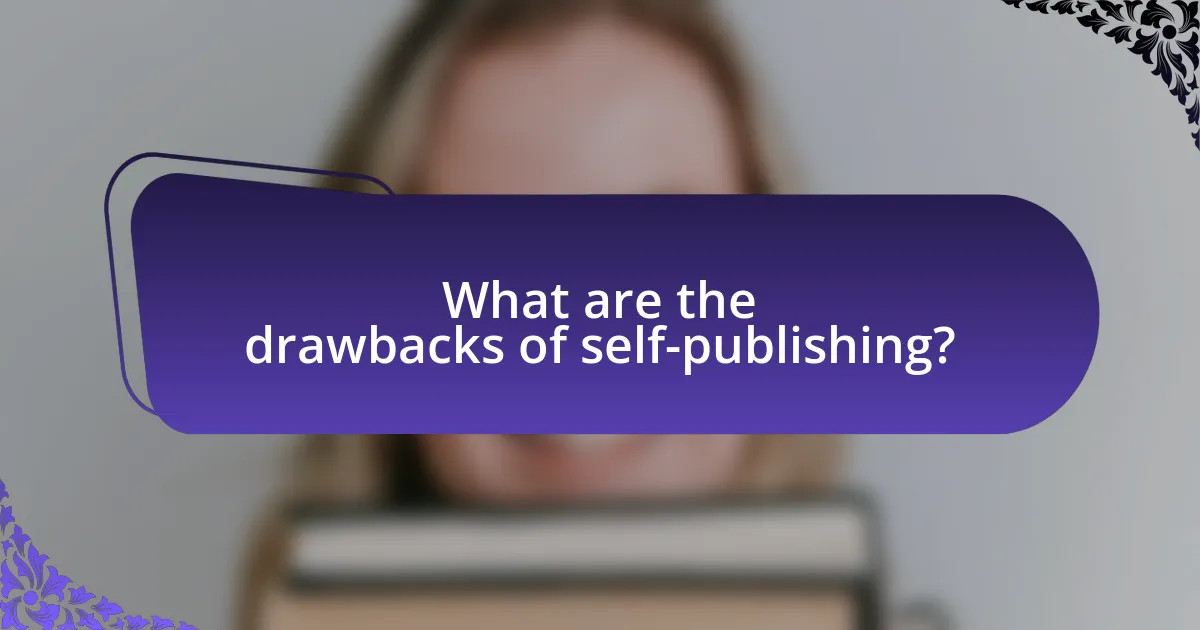
What are the drawbacks of self-publishing?
The drawbacks of self-publishing include limited distribution, lack of professional editing, and marketing challenges. Self-published authors often struggle to get their books into major bookstores and libraries, as many retailers prefer to work with traditional publishers. Additionally, without the support of professional editors, self-published works may suffer from quality issues, impacting reader reception. Furthermore, self-published authors must take on the responsibility of marketing their books, which can be time-consuming and requires expertise that many may lack. According to a survey by the Alliance of Independent Authors, 70% of self-published authors reported that marketing was their biggest challenge.
What challenges do self-published authors face in terms of quality?
Self-published authors face significant challenges in maintaining quality due to the lack of professional editing and oversight. Unlike traditional publishing, which typically includes a team of editors, proofreaders, and designers, self-published authors often must manage these aspects independently or rely on limited resources. This can lead to issues such as grammatical errors, inconsistent formatting, and subpar cover design, which negatively impact the reader’s experience. According to a survey by the Alliance of Independent Authors, 70% of self-published authors reported that they struggled with editing and formatting, highlighting the widespread nature of these quality challenges.
How can lack of professional editing impact a self-published book?
Lack of professional editing can significantly diminish the quality and credibility of a self-published book. Without professional editing, a book is likely to contain grammatical errors, inconsistencies, and unclear narratives, which can frustrate readers and lead to negative reviews. Research indicates that 70% of readers abandon books due to poor writing quality, highlighting the importance of editing in retaining audience engagement. Furthermore, self-published books without professional editing often struggle to compete with traditionally published works, which typically undergo rigorous editing processes, thereby affecting their marketability and sales potential.
What are the risks of poor cover design in self-publishing?
Poor cover design in self-publishing significantly increases the risk of low sales and negative perceptions of the book. A poorly designed cover fails to attract potential readers, as studies show that 75% of consumers judge a book by its cover. This lack of visual appeal can lead to decreased visibility in a crowded market, where first impressions are crucial. Furthermore, a subpar cover may convey a lack of professionalism, causing readers to question the quality of the content inside. In fact, research indicates that books with professional covers sell 50% more than those with amateur designs. Thus, the risks of poor cover design include diminished sales, negative reader perceptions, and reduced market competitiveness.
How does self-publishing affect distribution and visibility?
Self-publishing significantly enhances distribution and visibility for authors. Unlike traditional publishing, where distribution is often limited to specific retailers and markets, self-publishing allows authors to distribute their work globally through various online platforms such as Amazon Kindle Direct Publishing, Smashwords, and others. This broad access increases visibility, as self-published authors can reach diverse audiences without the constraints of traditional publishing gatekeepers. Furthermore, self-published authors retain control over marketing strategies, enabling them to tailor their visibility efforts to target specific demographics effectively. This flexibility is supported by data indicating that self-published books accounted for 30% of e-book sales in the U.S. in 2020, showcasing the growing impact of self-publishing on market reach and visibility.
What limitations do self-published authors encounter in bookstores?
Self-published authors encounter significant limitations in bookstores, primarily due to distribution challenges and lack of visibility. Many bookstores prioritize traditionally published works, which often have established distribution channels and marketing support, making it difficult for self-published authors to secure shelf space. Additionally, self-published books may lack the professional editing and design that traditional publishers provide, leading to perceptions of lower quality. According to a survey by the Independent Book Publishers Association, 70% of bookstores reported that they are less likely to carry self-published titles unless they are returnable and have a strong marketing plan. This highlights the barriers self-published authors face in gaining access to retail environments.
How can self-published authors ensure their books are discoverable online?
Self-published authors can ensure their books are discoverable online by optimizing their metadata, utilizing social media marketing, and engaging in targeted advertising. Optimizing metadata involves using relevant keywords in the book title, description, and categories, which improves visibility in search results. Social media platforms allow authors to build a following and promote their work directly to potential readers, with studies indicating that 70% of consumers are influenced by social media in their purchasing decisions. Additionally, targeted advertising on platforms like Amazon and Facebook can reach specific demographics, increasing the likelihood of book discovery.
What are the emotional and psychological challenges of self-publishing?
Self-publishing presents significant emotional and psychological challenges, including feelings of isolation, self-doubt, and anxiety. Authors often experience isolation due to the solitary nature of the self-publishing process, lacking the support systems typically found in traditional publishing environments. Self-doubt frequently arises as authors question the quality of their work and their ability to market it effectively, leading to anxiety about potential rejection or poor sales. Research indicates that these emotional hurdles can impact an author’s motivation and overall mental health, with studies showing that creative individuals are more susceptible to anxiety and depression. Thus, the emotional and psychological challenges of self-publishing are profound and can significantly affect an author’s journey.
How does the lack of support from a traditional publisher affect authors?
The lack of support from a traditional publisher significantly affects authors by limiting their access to resources such as marketing, distribution, and professional editing. Without these resources, authors often struggle to reach a wider audience, which can lead to lower sales and visibility. For instance, a study by the Authors Guild in 2018 indicated that self-published authors earn significantly less than traditionally published authors, primarily due to the absence of publisher-backed marketing efforts. Additionally, authors may face challenges in navigating the complexities of self-publishing, including formatting and cover design, which can detract from the overall quality of their work.
What pressures do self-published authors face in marketing their own work?
Self-published authors face significant pressures in marketing their own work, primarily due to limited resources and competition. Unlike traditionally published authors who often have access to established marketing teams and budgets, self-published authors must rely on personal investment of time and money to promote their books. This includes creating marketing strategies, managing social media, and engaging with readers, which can be overwhelming. Additionally, the self-publishing landscape is saturated, with over 1.7 million titles published in 2020 alone, making it challenging for individual authors to stand out and gain visibility. These factors contribute to the pressure self-published authors experience in effectively marketing their work.
What are the key considerations when choosing between self-publishing and traditional publishing?
When choosing between self-publishing and traditional publishing, key considerations include control over the publishing process, financial implications, and distribution reach. Self-publishing allows authors to retain full creative control and higher royalty rates, often up to 70%, compared to traditional publishing, where authors typically receive 10-15% royalties. Additionally, self-publishing requires authors to handle marketing and distribution, while traditional publishers offer established distribution channels and marketing support. According to a 2021 survey by the Authors Guild, 40% of authors reported higher earnings through self-publishing, highlighting the financial aspect as a significant factor in the decision-making process.
What tips can authors follow to make an informed decision about their publishing path?
Authors can make an informed decision about their publishing path by thoroughly researching both self-publishing and traditional publishing options. Understanding the differences in control, royalties, and marketing strategies is crucial; for instance, self-published authors retain full creative control and receive higher royalties, often around 70%, compared to traditional authors who typically earn 10-15% of book sales. Additionally, authors should evaluate their target audience and marketing capabilities, as self-publishing requires proactive promotion, while traditional publishing often provides established marketing support. Gathering insights from industry professionals and reading case studies can further clarify the advantages and disadvantages of each path, enabling authors to align their choice with their personal goals and resources.
